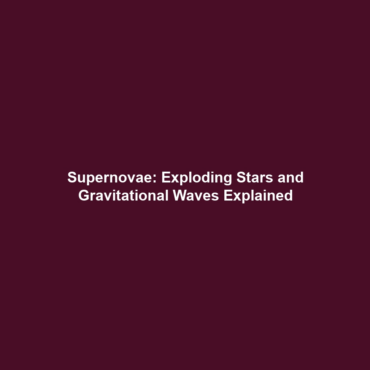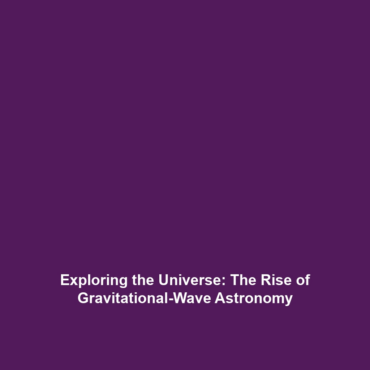Supernovae: How Exploding Stars Generate Gravitational Waves
Introduction
Supernovae are colossal cosmic events that mark the explosive death of stars, emitting vast amounts of energy and radiation. One of the most profound consequences of these stellar explosions is the generation of gravitational waves—ripples in spacetime that can provide crucial insights into the universe’s mysteries. Understanding how supernovae produce gravitational waves not only enhances our knowledge of these astronomical phenomena but also illustrates the broader significance of gravitational waves in astrophysics. In this article, we delve into the mechanisms behind supernovae, their relationship with gravitational waves, and the implications for future research.
Key Concepts
The Mechanism of Supernovae
Supernovae occur in two primary types: Type I and Type II. Each type has distinct mechanisms:
- Type I Supernova: This occurs in binary star systems where one star accumulates material from its companion, leading to a runaway nuclear fusion reaction.
- Type II Supernova: This is the result of the core collapse of a massive star, where the core becomes unstable and triggers an explosion.
Gravitational Waves from Supernovae
When a supernova explodes, it can create asymmetric distributions of mass and energy. This asymmetry is crucial for the production of gravitational waves, as the rapid changes in mass distribution create ripples in spacetime. These waves travel across the universe, allowing scientists to detect and study their properties.
Applications and Real-World Uses
The study of how supernovae generate gravitational waves has significant applications in the field of astrophysics:
- Astrophysical Observations: Gravitational waves provide a new way to observe cosmic events, offering insights complementary to electromagnetic observations such as light and radio waves.
- Understanding Cosmic Evolution: By studying gravitational waves from supernovae, researchers can learn more about the life cycle of stars and the dynamics of galaxies.
Current Challenges
Despite the advancements in gravitational wave astronomy, several challenges remain:
- Detection Sensitivity: Current detectors like LIGO still face limitations in sensitivity, making it difficult to capture faint signals from distant supernovae.
- Data Interpretation: Analyzing the complex data from gravitational wave signals requires advanced algorithms and models.
- Source Localization: Identifying the exact location of a supernova event in the universe requires precise measurements.
Future Research and Innovations
Upcoming research and technologies promise to enhance our understanding of supernovae and gravitational waves:
- Next-Generation Detectors: Instruments like the Einstein Telescope and LISA are expected to detect gravitational waves with improved sensitivity and resolution.
- Multi-Messenger Astronomy: Combining gravitational wave data with observations across multiple wavelengths will lead to a more comprehensive understanding of cosmic events.
Conclusion
In summary, supernovae are not just spectacular astronomical phenomena; they are also crucial generators of gravitational waves, offering profound insights into the workings of the universe. As research progresses, the implications for astrophysics and our understanding of gravitational waves will continue to grow. For more information on related topics, consider exploring articles on black holes and gravitational waves or neutron stars and their significance in gravitational observatories.









